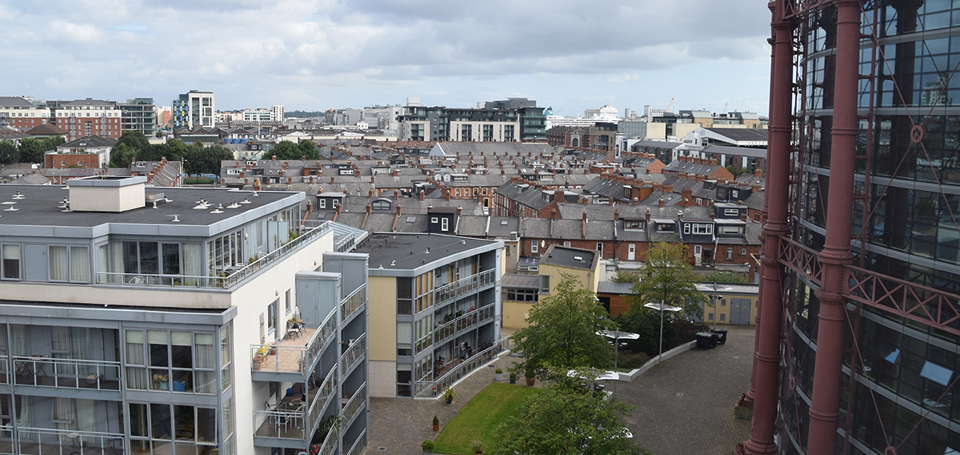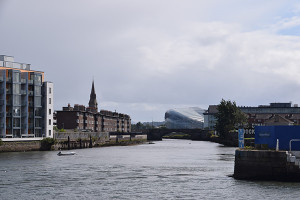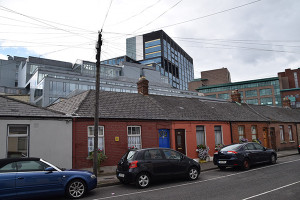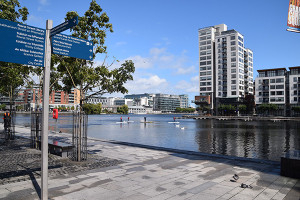4 Grand Canal Dock
Posted by Christine on Aug 19, 2014 in Ireland | 2 comments
As Ron and I planned this joint sabbatical, we envisioned renting an elegant mini-Georgian house or quaint mews in the toney Baggot Street to Ballsbridge corridor in Dublin 4. To our surprise, we find ourselves in a sunny top floor apartment in a new building with all mod cons in the trendy high tech quarter of Dublin next to the Grand Canal Dock, or GCD for short. It’s Dublin 4 all right, but “new” Dublin 4, where the city’s history provides the scaffolding for its future.
This is not the Dublin known to tourists, so finding out about its history takes some effort. Little by little, I’m figuring out the background of its structures, the meanings of street and building names, the stories—real and fictional—that cross my way as I map my own. In a city that is more than a thousand years old, stories abound.
Even the modern building where we live offers a way into the area’s past. This seven floor apartment building is called The Dickens to commemorate Charles Dickens’s visits to this part of the city in the mid-1800s; he came to perform and to reap the accolades his works had earned. Another is named The William Bligh after the controversial captain of HMS Bounty who survived the mutiny and went on to survey Dublin Bay in 1800-01. The Dickens and The William Bligh are part of a complex of eight apartment buildings called The Gasworks that adjoin on one end a Victorian gasometer, an enormous, round, expandable container formerly used for storing natural gas that has dominated this landscape since it was constructed in 1885. The gasometer is also an apartment building now, its rust-red, ornate wrought iron frame housing a torus or doughnut shaped inner structure that gives every flat two curved walls of windows. The deep spiral-shaped underground cavern that formed the gas transport system provides parking and recycling stations for the complex (press -4 on the elevator). We call it the “pit of doom” and dread our weekly descents.
It sounds a bit odd to say you live in The Gasworks, but this bygone industrial setting provides accommodation for today’s captains of industry. At the other end of complex opposite the gasometer and in and around Barrow Street are old and new buildings housing the European headquarters of Google, Facebook, LinkedIn, Twitter, and Airbnb, the world headquarters of Accenture (the world’s largest consulting firm), and lots of other similar businesses. Google is the biggest with three main buildings, including the tallest commercial building in Dublin. As you might expect, the area has earned the nickname “Silicon Dock.” These businesses are major contributors to Ireland’s economy and prestige, particularly in the wake of the country’s spectacular financial calamity in 2008. I guarantee you that we are the oldest people in the complex or the neighborhood. The unisex jewelry of choice here is an ID card on a lanyard. Everyone on the street is talking on a “mobile,” or tethered to earbuds, or both—often while riding a bike. The air must be positively abuzz with electrical activity, and I don’t even recognize all the languages I hear spoken on the short walk from our apartment to the Eurospar. People seem to move in and out all the time—there’s always someone lugging giant blue IKEA bags, looking haggard. Thanks to its youthful, busy, diverse population, the area is well supplied with gourmet grocery stores offering international specialties, restaurants, coffee shops, fitness centers, pubs and cafes with outdoor seating, hair salons, and other amenities, and in several places a line of taxis stands ready at all times to take harried executives to the airport. If Ireland is still suffering from the recession, it’s not evident in the GCD.
The Grand Canal—and its sister the Royal Canal on the north side of the city—were built in the eighteenth century to link the port of Dublin with the River Shannon and the rest of the country so that goods could be transported cheaper and faster. Both in the city and beyond, the canal adds to the landscape with its lush banks, ducks and swans, and quiet waters—“stilly / Greeny at the heart of summer” in the famous words of Patrick Kavanagh (“Lines Written on a Canal Bank Seat”). The Grand Canal Dock is a manmade harbor where the canal meets Dublin’s central waterway, the River Liffey, and since the River Dodder comes up from the south to enter the Liffey here, too, the neighborhood has lots of waterfront. Modern buildings mingle with bits of the old city like the neat “Belfast style” brick row houses on Gordon, Penrose, Hope, and Doris Streets built around 1900 to house dock workers.
Twenty years ago no one coming to the city wanted to live here; today it’s a destination. When maritime and river transport became less important, this part of Dublin faded from neglect. Shops closed, commercial activity shifted westward, buildings fell into disrepair. All that changed when high tech business began to relocate to the area. After years of lying derelict, the commercial buildings and row houses now command exorbitant rents and prices. A few months ago, in an economy that is barely recovering from the Great Recession, the government announced another major plan to invest in the area, a reminder of the ebb and flow of history’s favor. There’s been no commercial traffic on the Grand Canal since the 1960s, but at least at the GCD end of it, it’s a hub of international business and communication once again.
All of this along with the proximity of central Dublin—only a mile away—make the area an appealing place to live, work, or visit. It’s boomtown, and much more exciting than the staid suburban setting we imagined. It’s the new Dublin, a Dublin in the process of remaking itself, and the perfect vantage point for a rediscovery of the city.




Enjoyed this!
Thank you for introducing me to 20th-century Irish poet Patrick Kavanagh. When reading about him, I found this (on wikipedia no less, but citing the Poetry Foundations) and plan to read more of his work: “Although the literal idea of the peasant is of a farm labouring person, in fact a peasant is all that mass of mankind which lives below a certain level of consciousness. They live in the dark cave of the unconscious and they scream when they see the light.” He also commented that, although he had grown up in a poor district, “the real poverty was lack of enlightenment [and] I am afraid this fog of unknowing affected me dreadfully.” Unfortunately, it continues to affect us, the capital U.S., the us outside the cave, with consciousness and consciences in the 21st century. I look forward to tomorrow morning!!! Thank you, Christine. -Kathi